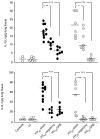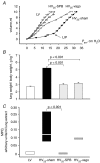Substance P receptor blockade decreases stretch-induced lung cytokines and lung injury in rats
- PMID: 20176632
- PMCID: PMC2872735
- DOI: 10.1113/jphysiol.2010.187658
Substance P receptor blockade decreases stretch-induced lung cytokines and lung injury in rats
Abstract
Overdistension of lung tissue during mechanical ventilation causes cytokine release, which may be facilitated by the autonomic nervous system. We used mechanical ventilation to cause lung injury in rats, and studied how cervical section of the vagus nerve, or substance P (SP) antagonism, affected the injury. The effects of 40 or 25 cmH(2)O high airway pressure injurious ventilation (HV(40) and HV(25)) were studied and compared with low airway pressure ventilation (LV) and spontaneous breathing (controls). Lung mechanics, lung weight, gas exchange, lung myeloperoxidase activity, lung concentrations of interleukin (IL)-1 beta and IL-6, and amounts of lung SP were measured. Control rats were intact, others were bivagotomized, and in some animals we administered the neurokinin-1 (NK-1) receptor blocking agent SR140333. We first determined the durations of HV(40) and HV(25) that induced the same levels of lung injury and increased lung contents of IL-1 beta and IL-6. They were 90 min and 120 min, respectively. Both HV(40) and HV(25) increased lung SP, IL-1 beta and IL-6 levels, these effects being markedly reduced by NK-1 receptor blockade. Bivagotomy reduced to a lesser extent the HV(40)- and HV(25)-induced increases in SP but significantly reduced cytokine production. Neither vagotomy nor NK-1 receptor blockade prevented HV(40)-induced lung injury but, in the HV(25) group, they made it possible to maintain lung injury indices close to those measured in the LV group. This study suggests that both neuronal and extra-neuronal SP might be involved in ventilator-induced lung inflammation and injury. NK-1 receptor blockade could be a pharmacological tool to minimize some adverse effects of mechanical ventilation.
Figures


 (A), airway pressure (Paw) (B), and arterial blood pressure (ABP) (C), in animals receiving low-pressure ventilation (LV), high-pressure ventilation at 40 cmH2O airway pressure (HV40-sham) and high-pressure ventilation at 25 cmH2O airway pressure (HV25-sham). Asterisks indicate significant differences versus baseline (**P < 0.01, ***P < 0.001). # indicates significant differences between HV40-sham and HV25-sham groups (#P < 0.05, ##P < 0.01).
(A), airway pressure (Paw) (B), and arterial blood pressure (ABP) (C), in animals receiving low-pressure ventilation (LV), high-pressure ventilation at 40 cmH2O airway pressure (HV40-sham) and high-pressure ventilation at 25 cmH2O airway pressure (HV25-sham). Asterisks indicate significant differences versus baseline (**P < 0.01, ***P < 0.001). # indicates significant differences between HV40-sham and HV25-sham groups (#P < 0.05, ##P < 0.01).



Comment in
-
Cytokines, neurokines or both? Mixed mechanisms of mechanical lung injury.J Physiol. 2010 Jun 1;588(Pt 11):1813-4. doi: 10.1113/jphysiol.2010.191478. J Physiol. 2010. PMID: 20516345 Free PMC article. No abstract available.
Similar articles
-
Histone deacetylase inhibitors trichostatin A and suberoylanilide hydroxamic acid attenuate ventilator-induced lung injury.Pharmazie. 2014 Jan;69(1):55-9. Pharmazie. 2014. PMID: 24601225
-
Anti-CD11c antibody, Efalizumab attenuate ventilator-induced lung injury.Eur Rev Med Pharmacol Sci. 2014;18(15):2182-90. Eur Rev Med Pharmacol Sci. 2014. PMID: 25070825
-
Neurokinin-1 receptor antagonist treatment protects mice against lung injury in polymicrobial sepsis.J Leukoc Biol. 2007 Sep;82(3):678-85. doi: 10.1189/jlb.0407217. Epub 2007 Jun 12. J Leukoc Biol. 2007. PMID: 17565047
-
Tiotropium bromide exerts anti-inflammatory effects during resistive breathing, an experimental model of severe airway obstruction.Int J Chron Obstruct Pulmon Dis. 2017 Jul 28;12:2207-2220. doi: 10.2147/COPD.S137587. eCollection 2017. Int J Chron Obstruct Pulmon Dis. 2017. PMID: 28814849 Free PMC article.
-
Hesperetin attenuates ventilator-induced acute lung injury through inhibition of NF-κB-mediated inflammation.Eur J Pharmacol. 2015 Dec 15;769:333-41. doi: 10.1016/j.ejphar.2015.11.038. Epub 2015 Nov 22. Eur J Pharmacol. 2015. PMID: 26610718
Cited by
-
Submarine rescue decompression procedure from hyperbaric exposures up to 6 bar of absolute pressure in man: effects on bubble formation and pulmonary function.PLoS One. 2013 Jul 2;8(7):e67681. doi: 10.1371/journal.pone.0067681. Print 2013. PLoS One. 2013. PMID: 23844058 Free PMC article.
-
Tachykinins and their receptors: contributions to physiological control and the mechanisms of disease.Physiol Rev. 2014 Jan;94(1):265-301. doi: 10.1152/physrev.00031.2013. Physiol Rev. 2014. PMID: 24382888 Free PMC article. Review.
-
Injurious mechanical ventilation affects neuronal activation in ventilated rats.Crit Care. 2011;15(3):R124. doi: 10.1186/cc10230. Epub 2011 May 13. Crit Care. 2011. PMID: 21569477 Free PMC article.
-
Activation of nicotinic cholinergic receptors prevents ventilator-induced lung injury in rats.PLoS One. 2011;6(8):e22386. doi: 10.1371/journal.pone.0022386. Epub 2011 Aug 8. PLoS One. 2011. PMID: 21857926 Free PMC article.
-
Airway response to acute mechanical stress in a human bronchial model of stretch.Crit Care. 2011;15(5):R208. doi: 10.1186/cc10443. Epub 2011 Sep 13. Crit Care. 2011. PMID: 21914176 Free PMC article.
References
-
- Balzamo E, Joanny P, Steinberg JG, Oliver C, Jammes Y. Mechanical ventilation increases substance P concentration in the vagus, sympathetic, and phrenic nerves. Am J Respir Crit Care Med. 1996;153:153–157. - PubMed
-
- Barnes PJ. Asthma as an axon reflex. Lancet. 1986;1:242–245. - PubMed
-
- Bhatia M, Moochhala S. Role of inflammatory mediators in the pathophysiology of acute respiratory distress syndrome. J Pathol. 2004;202:145–156. - PubMed
-
- Blumberg S, Teichberg VI. Biological activity and enzymic degradation of substance P analogs: Implications for studies of the substance P receptor. Biochem Biophys Res Commun. 1979;90:347–354. - PubMed
MeSH terms
Substances
LinkOut - more resources
Full Text Sources
Other Literature Sources
Research Materials

